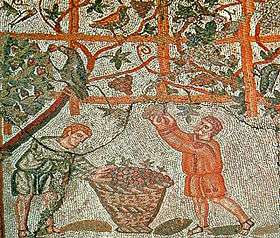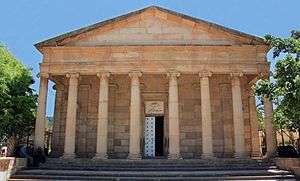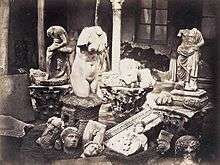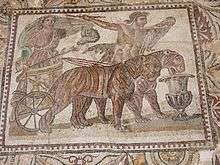Caesarea Mauretaniae
Caesarea Mauretaniae, meaning Caesarea of Mauretania in Latin, was a Roman-Berber colonia in the Maghreb.[1] It was the capital of Mauretania Caesariensis [2] and is now called Cherchell, in modern Algeria.
History
Antiquity to third century AD
Phoenicians from Carthage founded a settlement on the northern coast of Africa, 100 km west of the present-day city of Algiers at present Cherchell around 400 BC to serve as a trading station and named the city Iol or Jol.
It became a part of the kingdom of Numidia under Jugurtha, who died in 104 BC. Caesarea Mauretaniae became very significant to the Berber monarchy and generals of Numidia. The Berber Kings Bocchus I and Bocchus II lived there, as occasionally did other Kings of Numidia. Iol was situated in an area called Mauretania, which was then a part of the Numidian kingdom.
During the 1st century BC, due to the city’s strategic location, new defences were built.
The last Numidian king Juba II and his wife, the Greek Ptolemaic princess Cleopatra Selene II, were forced to flee the other part of Numidian kingdom because the local population disapproved of their king being too Romanized, which caused civil unrest between 26 and 20 BC. Roman Emperor Octavianus Caesar Augustus had intervened in the situation and in 33 BC Rome and divided the Numidian Kingdom into two. One half of the kingdom became a part of the Roman province of Africa Nova, while western Numidia and Mauretania (the second half of the kingdom) became one kingdom in the hands of a Berber prince named Juba II. Although his father was once an ally of Pompey, Juba had lived in Rome under the tutelage of Julius Caesar, learning to read and write Greek and Latin. As he was considered too Roman to rule, Juba and his wife, Cleopatra Selene (the daughter of Marcus Antonius and last Pharaonic queen Cleopatra), were at the mercy of civil unrest when Emperor Augustus intervened. Juba II renamed Iol Caesarea or Caesarea Mauretaniae, in honor of the emperor. Caesarea would become the capital of the Roman client kingdom of Mauretania, which became one of the important client kingdoms in the Roman Empire, and their dynasty was among the most loyal client Roman vassal rulers.
Juba and Cleopatra did not just rename their new capital, but rebuilt the town as a typical Graeco-Roman city in fine Roman style on a large, lavish and expensive scale, complete with street grids, a theatre, an art collection and a lighthouse similar to the one at Alexandria. The construction and sculptural projects in Caesarea and throughout the kingdom were built in a rich mixture of ancient Egyptian, Greek and Roman architectural styles. The monarchs are buried in their mausoleum, the Royal Mausoleum of Mauretania which can still be seen. The seaport capital and its kingdom flourished during this period with most of the population being of Greek and Phoenician origin with a minority of Berbers. It remained a significant power center under Numidian rule with a Greco-Roman civilization as a veneer, until 40 AD, when its last monarch Ptolemy of Mauretania was murdered on a visit to Rome. The murder of Ptolemy set in motion a series of reactions resulting in a devastating war with Rome.
In 44 AD after a four-year bloody revolt, the capital was captured and Roman Emperor Claudius divided the Mauretanian kingdom into two provinces. The province of which Caesarea became the capital was called Mauretania Caesariensis after it. The city itself was settled with Roman soldiers and was given the rank of a colonia, and so was also called Colonia Claudia Caesarea.
In later centuries, the Roman population expanded, as did the Berber population, resulting in a mixed Greco-Phoenician, Berber and Roman population. The city featured a hippodrome, amphitheatre, basilica, numerous Greek temples and Roman civic buildings.[3] During this heyday, the city had its own school of philosophy, academy and library. As a significant city of the Roman Empire it had trading contacts across the Roman world.
Subsequently, the town was the birthplace of the Roman Emperor Macrinus and Greek grammarian Priscian.
Additionally, the city also featured a small but growing population of converted Christians and was noted for the religious debates and tumults which featured the hostility of Roman public religion toward Christians. Caesarea thus has its own martyred Catholic saint, Marciana (her feastday is on 9 January). This virgin martyr was accused of vandalizing a statue of the goddess Diana. After being tortured, Marciana was gored by a bull and mauled by a leopard in the amphitheatre at Caesarea. By the 4th century, the conversion of the population from pagan to Christian beliefs resulted in nearly half of the population being Christianized.
During the decline of Roman empire

In the 5th century, the city remained an extremely loyalist power for the Roman Empire. Additionally, the city's elite held considerable control of international trade. Although the city had been in a state of stagnation for over a hundred years and had even lost population as most cities in the Roman Empire, it still remained much as it had been since establishment. Consequently, the Roman Empire relied on much of its North African dominion for essential food stuffs, luxury goods and a not insignificant number of elite rulers.
Thus, in the waning days of the Empire it became a target of the Vandals and their expedition to bring down their Imperial opponents. A Vandal army and fleet burnt the town and fortified many of its old magnificent Roman era buildings into Vandal citadels. Although this devastation was significant, the Vandal era saw restoration of much of the damage, an expansion in the size of the population, and the creation of a vibrant Romanized Germanic community.
The city's port meanwhile served as a base for some of the Vandal fleet which continued to reign supreme in the western seas. In turn, the city saw its economic fortunes revive as Vandal merchants cornered the market on shipping. However, much of this wealth was of necessity channeled toward military developments, as the Vandals were forced to defend their conquest against both Byzantine and Berber attacks.
After several decades of war with the Eastern Roman Emperor, the Vandal Kingdom of Africa was ground down and the city was recaptured under the Byzantine Empire's Emperor Justinian I. The Emperor kept the walls strong but tore down the Vandal citadels, restored the old Roman buildings and returned to the city to a traditional post of Byzantine civilization.
However, the vibrant Germanic community which had brought new economic development to the area was ruthlessly suppressed. Although the majority of its population was left unscathed, its economic power was ruined and its place as an aristocracy was overthrown with new Byzantine courtiers.
Romanization and Christianity center
Considered to be one of the more loyal of Roman provincial capitals, Caesarea grew under Roman rule in the 1st and 2nd century AD, soon reaching a population of over 30,000 inhabitants.[4] In 44 AD, dng the reign of Emperor Claudius it became the capital of the imperial province of Mauretania Caesarensis. Later, the emperor made it a colonia, “Colonia Claudia Caesarea”. As with many other cities throughout the empire, he and his successors further Romanised the area, building monuments, enlarging the bath houses, adding an amphitheatre, and improving the aqueducts. Later, under the Severan dynasty, a new forum was added. The city was sacked by Berber tribes during a revolt in 371/372 AD, but recovered.
In later centuries, the Roman population expanded, as did the Berber population, resulting in a mixed Berber and Roman population. The city was mostly Romanized under Septimius Severus and it grew to be a very rich city with nearly 100,000 inhabitants, according to historian Gsell. In about 165 AD, it was the birthplace to the future Roman Emperor Macrinus.
From an early stage, the city had a small but growing population of Christians, Roman and Berber and was noted for the religious debates and tumults which featured the hostility of Roman public religion toward Christians. By the 4th century, the conversion of the population from pagan to Christian beliefs resulted in nearly all of the population being Christianised.
By the 5th century the capital of Mauretania Caesariensis was totally Romanised, according to Theodore Mommsen, one of the 80 cities in the Maghreb populated (and sometimes even created) by Roman colonists from Italy. It remained an extremely loyalist force for the Roman Empire. Additionally, the Romanized city's elite held considerable control of international trade. Although it stagnated for over a hundred years and even lost population, as did most cities in the Roman Empire, it still remained much as it had been since it was founded. Consequently, the Roman Empire largely relied on its North African dominion for essential grain supply and some elite rulers.
It became a target of the Vandals and was finally taken over by them in 429 AD. The Vandal army and fleet burnt the town and turned many of its old magnificent Roman era buildings into Vandal citadels. Although this devastation was significant, the Vandal era saw restoration of much of the damage, an expansion in population, and the creation of a vibrant Romanised Germanic community.
The area and remained in Vandal hands until 533 AD, when the city was captured by the Byzantine Emperor Justinian I. The new rulers used the Greek language (along with Latin), but the Neo-Latin local dialect remained in use by the inhabitants. The city declined. The Roman and the semi-Romanised Vandal population held a stratified position over the growing numbers of Berbers it allowed to settle in return for cheap labor.[5] This reduced the economic status of small freeholders and urban dwellers, especially what remained of the Vandal population, who provided most of the local military forces. Furthermore, the increasing use of Berber workers ground down the Roman population of free peasants. By the 8th century, the city and surrounding area had neither a strong urban middle class of free citizens, nor a rural population of freehold farmers, nor a crack military aristocracy of Vandal warriors and their retinue. It thus succumbed to an Arab Moslem jihad.
Muslim age

Successive waves of Islamic jihads into Byzantine North African territory over 15 years wore down the smaller and less motivated imperial forces, until finally Moslem tribesmen laid siege to the city of Caesarea and, although the defenders were resupplied by Byzantine fleets, finally overwhelmed it. Much of the Byzantine nobility and officials fled to other parts of the Empire, while most of the remaining Roman and semi-Roman Berber population accepted Islamic rule which granted them protected status.
Some remained Christians, but hope of living as free Christians under Islamic rulers was dashed[6] For two generations what remained of the Roman population and Romanized Berbers launched several revolts often in conjunction with reinforcements from the Empire. In turn, Islamic forces would react with even more death and oppression. After several revolts by Berbers and what remained of the Romano-Berber and tiny partially Vandal populations, Arab Moslems in the ninth century tore down much of the city's defences and recycled its crumbling Roman buildings, leaving the former city little more than a small village and pale relic of its former glory, surrounded by a camp of Moslem warriors and their retinue. Additionally, the various Jihads and growing numbers of Arab tribesmen forcibly converted the majority of the population to Islam over two centuries of oppression and war. As a result, most of what remained of Roman and Vandal civilization, including the language and christianity disappeared under the onslaughts of Arab attacks.
Nonetheless, after the tenth century later Berbero-Islamic rule was more tolerant and respectful of the Greco-Roman Christian past and endeavored to rebuild aspects of the town's former civilization. For the following few centuries, the city remained a power center of Arabs and Berbers with a small but significant population of semi-Roman Christians who were fully assimilated by the beginning of the early Renaissance.
The inhabitants became increasingly Arabised. By the 10th century, the city's name had transformed in the local dialect from a Latin to a Berber and ultimately into the Arabised form Sharshal (in French orthography, Cherchell).
Ecclesiastical history
Apart from some bishops who may have been of the church in Caesarea and whose names are engraved in inscriptions that have been unearthed, the first bishop whose name is preserved in extant written documents is Fortunatus, who took part in the Council of Arles of 314, which condemned Donatism as heresy. A letter of Symmachus mentions a bishop named Clemens in about 371/372 or 380. The town became a Donatist centre and at the joint Conference of Carthage in 411, was represented both by the Donatist Emeritus and by the Catholic Deuterius. Augustine of Hippo has left an account of his public confrontation with Emeritus at Caesarea in the autmn of 418, after which Emeritus was exiled. The last bishop of Caesarea whose name is known from written documents was Apocorius, one of Catholic bishops whom Huneric summoned to Carthage in 484 and then sent into exile. An early 8th-century Notitia Episcopatuum still included this see.[7][8]
Titular see
No longer a residential bishopric, Caesarea in Mauretania is today listed by the Catholic Church as a titular see.[9]
The diocese was nominally restored as a titular bishopric under the name Ceasarea in the 19th century, which was specified as Caesarea in Mauretania in 1933.
It has had many incumbents, both of the lowest (episcopal) and intermediary (archiepiscopal) ranks :
- Titular Bishop Biagio Pisani (1897.04.23 – 1901.06.07) (later Archbishop)
- Titular Bishop Pietro Maffi (1902.06.09 – 1903.06.22) (later Cardinal)
- Titular Bishop Thomas Francis Brennan (1905.10.07 – 1916.03.20)
- Titular Archbishop Pierre-Célestin Cézerac (1918.01.02 – 1918.03.18)
- Titular Archbishop Cardinal Wilhelmus Marinus van Rossum, Redemptorists (C.SS.R.) (1918.04.25 – 1918.05.20)
- Titular Archbishop Benedetto Aloisi Masella (1919.12.15 – 1946.02.18) (later Cardinal)
- Titular Bishop Luigi Cammarata (1946.12.04 – 1950.02.25)
- Titular Bishop Francesco Pennisi (1950.07.11 – 1955.10.01)
- Titular Bishop André-Jacques Fougerat (1956.07.16 – 1957.01.05)
- Titular Bishop Carmelo Canzonieri (1957.03.11 – 1963.07.30)
- Titular Bishop: Archbishop Enea Selis (1964.01.18 – 1971.09.02)
- Titular Bishop Giuseppe Moizo (1972.01.22 – 1976.07.01)
- Titular Archbishop Sergio Sebastiani (1976.09.27 – 2001.02.21) (later Cardinal)
- Titular Bishop Gerard Johannes Nicolaas de Korte (2001.04.11 – 2008.06.18)
- Titular Bishop Stanislaus Tobias Magombo (2009.04.29 – 2010.07.06)
- Titular Archbishop Walter Brandmüller (2010.11.04 – 2010.11.20) (later Cardinal)
- Titular Archbishop (2011.11.26 – ...): Marek Solczyński Apostolic Nuncio (papal ambassador) to Azerbaijan, Armenia and Georgia (2011.11.26 – ...).
Remains
Earthquakes, wars and plunder have ravaged many of the ancient remains.
The towwn (of Caesarea) remains insufficiently known....The town walls, studied in 1946, pose more problems; and the monuments are more often simply marked than completely known. The amphitheater, which has been excavated, remains unpublished; the very large hippodrome, which appears clearly on aerial photographs, is known only through old borings. The temples, which have been found on a spur of the mountain to the East of the central esplanade, on the edge of the route from Ténès to the West of the modern town, are too much destroyed to warrant publication even of plans. The baths along the edge of the sea, rather majestic, are also badly preserved. One would scarcely recognize several houses recently excavated. Grouped around peristyles with vast trichinia, they are readily adapted to the terrain and are constructed on terraces on the lower slopes or on the edge of cliffs with views over the sea. They often are preserved for us only in a late form—4th c. A.D.—and traces of the era of Juba are found only in the lower strata. The theater is an exception; still well preserved in 1840, it has since served as a quarry. It was set against the slope of the mountain. At the back of the scaena towards the N was a portico, covered over today by a street, where Gsell saw the S side of the forum. Of the rich scaenae frons there remain only traces and several statues, of which two are colossal muses. The orchestra had hater undergone great modification which had resulted in the disappearance of the platform of the stage: an oval arena had been built, intended for hunting spectacles, and a wall was raised between the first row of seats and the cavea to protect spectators from the wild beasts. The sumptuously decorated monument is consequently very much mutilated, but is of interest specifically because of its complex history.The amphitheater, in the E part of the town, was erected in flat open country. It was not oval but rectangular, with the short sides rounded. The tiers of seats, for the most part missing, were carried on ramping vaults, and the arena floor was cut by two perpendicular passages intended for beasts. It is in this arena that St. Marciana was martyred.[10]
Some remains can be seen in the local Archeological Museum of Chercell-Caesarea.
Gallery
-
Roman amphiteater
-

Section of Caesarea's Roman acqueduct
-

Photography of ancient Roman inscriptions from Cherchell, 1856
-

Photography of Roman remains from Caesarea, 1856
-
Mosaic "Les tres Graces" (the 3 beauties) from Caesarea
-

Portrait of Juba II, found in Caesarea
-

Mosaic of vineyard workers
-

Mosaic of the leopards
Notes
- ↑ Detailed map of Roman Berber Africa, showing the location of Iol-Caesarea on the Mediterranean coast
- ↑ Ph. Leveau: Caesarea Mauretaniae (in French)
- ↑ Leveau Philipe: "L'amphithéâtre et le théâtre-amphithéâtre de Cherchel" (in French)
- ↑ Leveau, Philippe. "Caesarea de Maurétanie, une ville romaine et ses campagnes" first chapter
- ↑ Leveau, Philippe. "Caesarea de Maurétanie, une ville romaine et ses campagnes" third chapter
- ↑ Virginie Prevost. "Prevost: Les dernières communautés chrétiennes autochtones d’Afrique du Nord" ()
- ↑ Joseph Mesnage, L'Afrique chrétienne, Paris 1912, pp. 447–450
- ↑ Charles Courtois, v. Césarée de Maurétanie, in Dictionnaire d'Histoire et de Géographie ecclésiastiques, vol. XII, Paris 1953, coll. 203-206
- ↑ Annuario Pontificio 2013 (Libreria Editrice Vaticana 2013 ISBN 978-88-209-9070-1), p. 867
- ↑ Princeton: Iol
Source and External links
- GigaCatholic with titular incumbent biography links
- Cesarea di Mauretania (Treccani)
- History with detailed maps of Caesarea Mauretaniae
Bibliography
- Leveau, Philippe. Caesarea de Maurétanie. Une ville romaine et ses campagnes.École française de Rome. Roma, 1984
- Nacéra, Benseddik, De Caesarea à Shershel."Actes du Coll. Intern. sur l’Hist. et l’Arch. de l’Afrique du Nord", Grenoble 1983, C.T.H.S., 19b, 1983, p. 451-456.
- Prevost, Virginie. Les dernières communautés chrétiennes autochtones d’Afrique du Nord. Armand Colin ed. (p. 461-483)
- Smith Reid, James. The Municipalities of the Roman Empire. The University of Michigan Press. Chicago, 1913
%2C_Algeria_04966r.jpg)